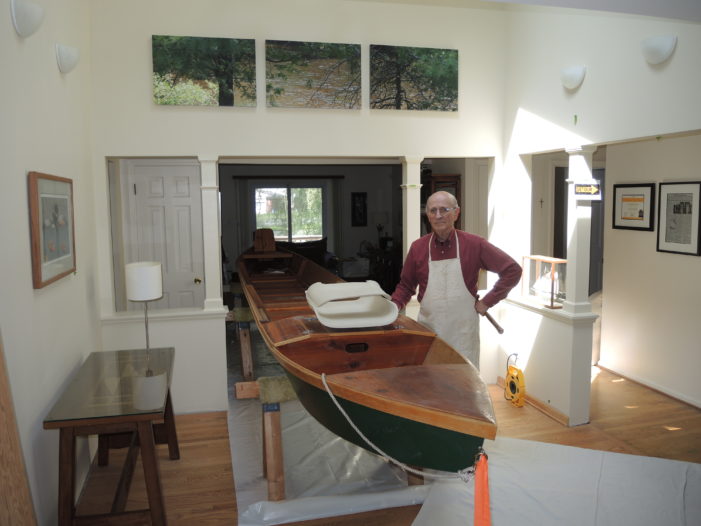Jim Meloche of Clarkston works on his longboat in his home. Photo by Phil Custodio
BY PHIL CUSTODIO
Clarkston News Editor
Jim Meloche enjoys building model boats in his home in Clarkston. The boat he’s been working on most recently is 26 feet long.
Meloche has been constructing his Au Sable River fishing longboat for more than three decades and was recently finishing it up.
“When it’s done, I’ll bring it up north to the fly shop and they’ll help me sell it,” he said.
He was storing the in-progress boat at his cabin on the Au Sable since he started it in 1986. He sold the cabin in February, so he brought the vessel to his home in Clarkston.
At 26-feet long, it was too big for his Clarkston garage, so he has been finishing it in the living room of his home.
“Most of the work has been done here in Clarkston,” he said. “I got interested in the idea of building the boat when I read a Nov. 27, 1985, article in The Clarkston News, ‘Boats of the fishermen three.'”
The article explains how Independence Township friends Stephen Werner, Robert Unsworth, and Tudor ApMadoc obtained plans for the boats from Au Sable fishermen and constructed their own.
“I contacted Steve Werner and we became friends,” said Meloche, who has lived in Clarkston since 1975. “There are no plans for the boats. We looked at other people’s boats up north. They’re unique to northern Michigan, the Au Sable River.”
His version is typical of the type, long and slender like a canoe, with a flat bottom for stability. The captain sits in the back with a guest in front. A third can sit in the middle, so three can fish at the same time without tangling their lines. They float along with the flow of the river, though the captain can steer with a pole and regulate speed with chains dragged along the bottom.
“Let all the chain down to stop. Let it all up for full speed, the speed of the current,” Meloche said.
His boat is made of wood from the Clarkston area, along with cedar from Werner’s farm. Years ago, boats were made of three planks steamed together, two for the sides and one for the bottom. After World War II, they started using plywood with epoxy.
“The sides give the boat rigidity so you can walk in it and it won’t rock,” he said.
Under the front seat is a fish box with five holes drilled through the bottom to allow water to flow into it from the river, keeping the fish alive.
The design also includes floor boards covered in snag-proof carpet, a notched, watertight beer box, and a polyurethane coating – the final step in the boat’s construction.
Meloche will also include for sale the boat’s trailer and an engine, a Mercury five horsepower model.
“It’s a neat engine. I think it’s no longer made,” he said. “This boat has never been in the water. It’s one of a kind, hand made with bronze screws, weighing about 130 pounds, and it’s all ship shape.”
Historians estimate about 300 of the fishing boats still exist, though some have been repurposed into coffee tables and other items. One longboat is on display in the state historical museum in Lansing.
Free of the boat and cabin, Meloche plans to continue fishing up north with his kids and grandkids.
“Now I can go to different places, instead of being tied to the same patch,” he said.

